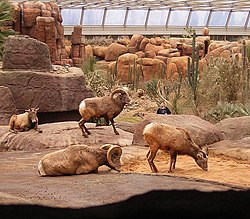| Royal Burgers' Zoo | |
|---|---|
 Bighorn sheep in Burgers' Desert | |
 | |
| 52°00′36″N5°53′59″E / 52.01000°N 5.89972°E | |
| Location | Arnhem, Netherlands |
| Land area | 45 ha (110 acres) [1] |
| No. of animals | 10,000+ [2] |
| No. of species | 500+ [2] |
| Total volume of tanks | 8,000,000 L (2,100,000 US gal) |
| Annual visitors | 1.415 million (2014) [3] |
| Memberships | NVD, [4] EAZA, [5] WAZA [6] |
| Website | www |
Royal Burgers' Zoo (Dutch : Koninklijke Burgers' Zoo) is a 45-hectare (110-acre) zoo in Arnhem, Netherlands, and is one of the biggest zoos in the country. Arnhem is a city that lies partially in the Veluwe, a nature park in the east of the Netherlands. The zoo is popular with both Dutch and German people, and receives about 1 million visitors annually. It was founded by Johan Burgers in 1913.
Contents
The zoo is a member of the Dutch Zoo Federation (NVD), the European Association of Zoos and Aquaria (EAZA), the International Species Information System (ISIS), and the World Association of Zoos and Aquariums (WAZA).
